How to learn crypto technical analysis
How to read cryptocurrency technical analysis charts
There are many methods used in technical analysis, but they usually belong to a specific type:
Trade statistics: volumes, etc.
Candlestick analysis
Chart patterns
Resistance and support levels
Technical indicators
Experienced traders usually combine several different techniques in their methods and wait for their mutual confirmation. A confirmed signal can be considered more reliable for decision-making.
It's important to understand that you can't know for sure how the price will move in the future. But you can determine which situations are probably good for opening a position and which aren't. That's why it's always important to keep risk management in mind.
Timeframes
There's no perfect timeframe for any coin at any given time. Longer timeframes are generally more important, but this doesn't mean that you won't find good trades on shorter timeframes. Check multiple timeframes and evaluate trading opportunities accordingly.
The choice of a timeframe depends on a trader's trading strategy. So-called scalpers, who open and close their positions quickly, prefer very short timeframes, such as 1-minute or 5-minute charts. Intraday traders, who usually enter and exit trades within a single day, primarily use 5-minute, 15-minute or hourly charts. Finally, position traders who prefer a long-term approach to trading use daily or even weekly charts.
When the market experiences heavy fluctuations, a shorter timeframe is often more appropriate for identifying better entry and exit points than a longer timeframe.
Volume
Trading volume plays a major role in the technical analysis of cryptocurrency and other assets. Volume is the number of coins traded in a chosen timeframe. It's often shown as a row of columns along the bottom of a price chart. The height of these columns serves as a visual identifier of the volume. Volume indicates just how serious a trend is. Stronger trends are accompanied by higher trading volume and vice versa.
Candlestick
Japanese candlesticks are the most popular chart type for reading and analysing price charts. Each of these candles shows a coin's price movement during a selected timeframe. Every candle consists of a body and up to two shadows and can be green or red. The body represents the difference between the opening and closing prices. If the body is green, the bottom of it shows the opening price, and the top of it shows the closing price. For red candles, the opposite is true. Thus, the green candlestick shows that the closing price in this period was higher than the opening price, i.e., the price increased. Green candles are called "bullish". In turn, a red candle indicates a decline in price and is called "bearish".
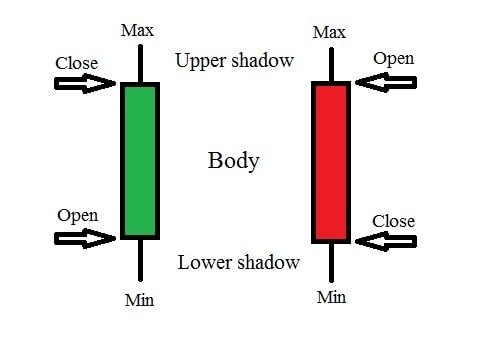
Japanese candlesticks
The shadows that come out of the body show the range of prices from lowest to highest within that period.
This type of price chart is very useful because it shows us the most important information about price movements at a given time. We clearly understand if the price rose or fell in the selected timeframe, and we see the maximum and minimum price values for that period.
Sometimes, groups of candlesticks fall into recognisable patterns with their own names. Let's look at some of them.
Bullish reversal patterns
Bullish reversal patterns are formed after a decline in price and indicate a possible change of the trend.
The bullish hammer is a one-candle pattern. The body of the candle is short with a small to no upper shadow and a long lower shadow. This is a sign that sellers are driving the price lower during the period, followed by strong pressure from buyers that ended the period with a higher close.
Bullish hammer pattern------->𝐈𝐟 𝐲𝐨𝐮 𝐰𝐚𝐧𝐭 𝐭𝐨 𝐛𝐞𝐜𝐨𝐦𝐞 𝐄𝐱𝐩𝐞𝐫𝐭 𝐩𝐥𝐞𝐚𝐬𝐞 𝐟𝐨𝐥𝐥𝐨𝐰 𝐭𝐡𝐞𝐬𝐞 𝐠𝐮𝐢𝐝𝐞 𝐥𝐢𝐧𝐞 𝐟𝐫𝐨𝐦 𝐭𝐡𝐢𝐬 :https://tinyurl.com/foresxtrendy
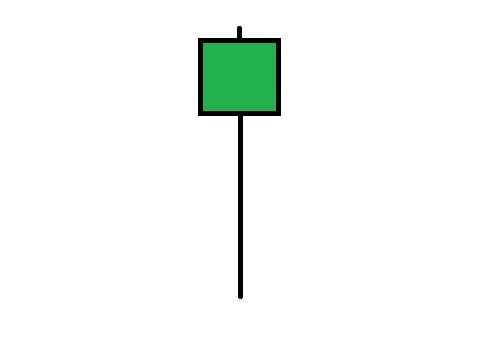
The bullish engulfing is a two-candle pattern. The body of the second, bullish candle completely covers the body of the first candle, which is bearish. That pattern means that pressure from buyers overwhelmed sellers, and the bullish movement had stronger momentum than the bearish one.
Bullish engulfing pattern
𝐈𝐟 𝐲𝐨𝐮 𝐰𝐚𝐧𝐭 𝐭𝐨 𝐛𝐞𝐜𝐨𝐦𝐞 𝐄𝐱𝐩𝐞𝐫𝐭 𝐩𝐥𝐞𝐚𝐬𝐞 𝐟𝐨𝐥𝐥𝐨𝐰 𝐭𝐡𝐞𝐬𝐞 𝐠𝐮𝐢𝐝𝐞 𝐥𝐢𝐧𝐞 𝐟𝐫𝐨𝐦 𝐭𝐡𝐢𝐬 𝐥𝐢𝐧𝐤:https://tinyurl.com/foresxtrendy
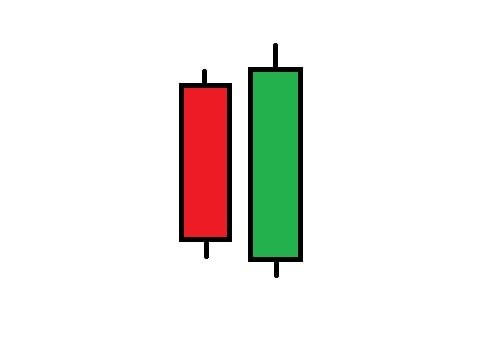
The morning star is a three-candle pattern. It consists of a candle with a very small body between long bearish and bullish candles. Additionally, the body of the middle candle doesn't overlap with the body of the bearish one. The pattern means that pressure from sellers has been exhausted, and the trend is now bullish.
Morning star pattern
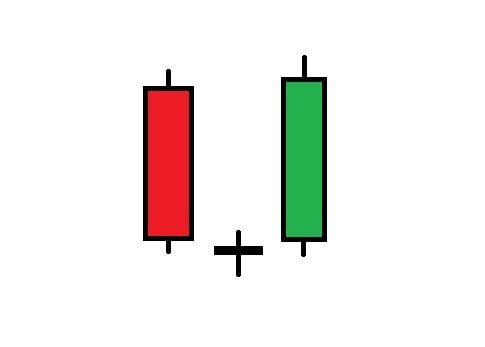
Bearish Reversal Patterns
The shooting star is a one-candle pattern that is essentially the opposite of the bullish hammer pattern. A shooting star candle has a small body, little to no lower shadow, and a long upper shadow.
Shooting star pattern𝐈𝐟 𝐲𝐨𝐮 𝐰𝐚𝐧𝐭 𝐭𝐨 𝐛𝐞𝐜𝐨𝐦𝐞 𝐄𝐱𝐩𝐞𝐫𝐭 𝐩𝐥𝐞𝐚𝐬𝐞 𝐟𝐨𝐥𝐥𝐨𝐰 𝐭𝐡𝐞𝐬𝐞 𝐠𝐮𝐢𝐝𝐞 𝐥𝐢𝐧𝐞 𝐟𝐫𝐨𝐦 𝐭𝐡𝐢𝐬 𝐥𝐢𝐧𝐤:
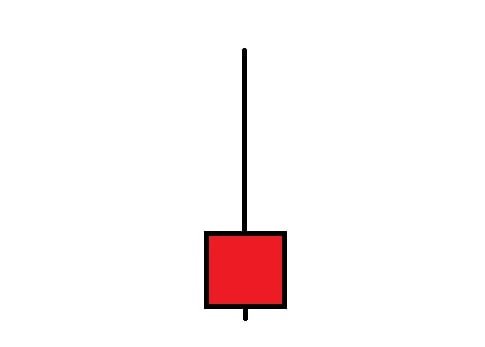
The bearish engulfing is a two-candle pattern. As its name implies, it's the opposite of the bullish engulfing pattern. It consists of a first bullish candle with its body completely covered by a second bearish candle.
Bearish engulfing pattern𝐈𝐟 𝐲𝐨𝐮 𝐰𝐚𝐧𝐭 𝐭𝐨 𝐛𝐞𝐜𝐨𝐦𝐞 𝐄𝐱𝐩𝐞𝐫𝐭 𝐩𝐥𝐞𝐚𝐬𝐞 𝐟𝐨𝐥𝐥𝐨𝐰 𝐭𝐡𝐞𝐬𝐞 𝐠𝐮𝐢𝐝𝐞 𝐥𝐢𝐧𝐞 𝐟𝐫𝐨𝐦 𝐭𝐡𝐢𝐬 𝐥𝐢𝐧𝐤:https://tinyurl.com/foresxtrendy
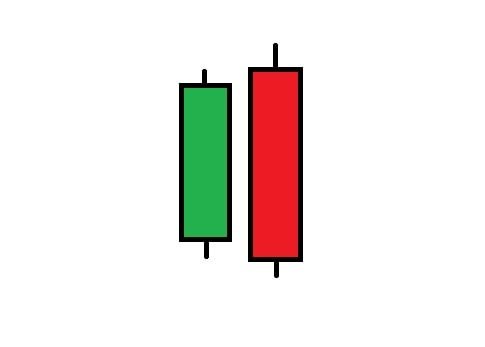
The evening star. As you may have already guessed, this is the opposite of the morning star pattern. It consists of a candle with a very small body between two long candles, the first one bullish and the second bearish.
Evening star pattern𝐈𝐟 𝐲𝐨𝐮 𝐰𝐚𝐧𝐭 𝐭𝐨 𝐛𝐞𝐜𝐨𝐦𝐞 𝐄𝐱𝐩𝐞𝐫𝐭 𝐩𝐥𝐞𝐚𝐬𝐞 𝐟𝐨𝐥𝐥𝐨𝐰 𝐭𝐡𝐞𝐬𝐞 𝐠𝐮𝐢𝐝𝐞 𝐥𝐢𝐧𝐞 𝐟𝐫𝐨𝐦 𝐭𝐡𝐢𝐬 𝐥𝐢𝐧𝐤:https://tinyurl.com/foresxtrendy
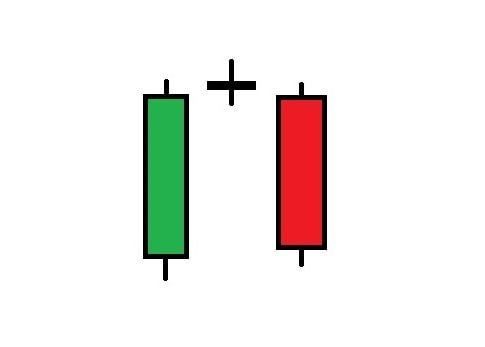
Support and resistance levels
Support and resistance levels are key price levels where buyers or sellers, respectively, enter the market and make a sufficient volume of trades to stop or reverse a price movement. These levels are indicated by touching a price multiple times without crossing it.
Support and resistance levels
The support level is the level where asset demand is strong enough to stop the price from falling lower. Support is always below the current price. Traders tend to buy at the support level, which drives the price up.
Resistance is the level where an asset's supply is strong enough to stop the price from rising higher. The resistance level is always above the current price. Traders tend to sell at resistance levels, which drives the price down.
Once a price breaks through the resistance level, it becomes the new support. Likewise, if the price breaks through a support level and goes lower, that support level becomes the new resistance.𝐈𝐟 𝐲𝐨𝐮 𝐰𝐚𝐧𝐭 𝐭𝐨 𝐛𝐞𝐜𝐨𝐦𝐞 𝐄𝐱𝐩𝐞𝐫𝐭 𝐩𝐥𝐞𝐚𝐬𝐞 𝐟𝐨𝐥𝐥𝐨𝐰 𝐭𝐡𝐞𝐬𝐞 𝐠𝐮𝐢𝐝𝐞 𝐥𝐢𝐧𝐞 𝐟𝐫𝐨𝐦 𝐭𝐡𝐢𝐬 𝐥𝐢𝐧𝐤:------->https://tinyurl.com/foresxtrendy
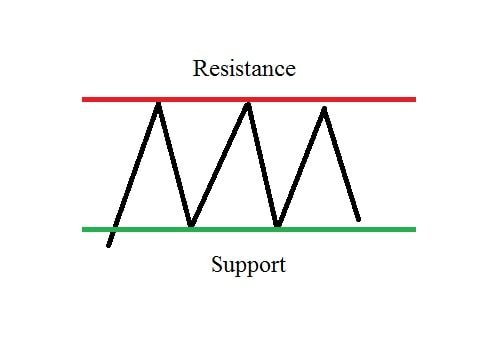
Your post was upvoted and resteemed on @crypto.defrag
Thank you so much......:)
You've got a free upvote from witness fuli.
Peace & Love!
Thank you so much